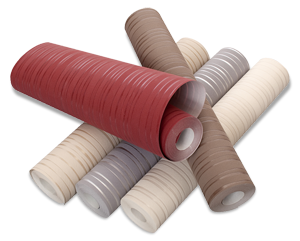Explore All the Types of Wallpaper for Your Home
A homeowner looking to give a room a new look often considers wallpaper. The options out there, however, appear innumerable, factoring in backing, strength, and material. So, what’s the right choice?
We describe common types of wallpaper and wall coverings to help you narrow down your selection:
Borders: The smallest and simplest, this wallpaper features a design printed onto a paper backing. Vinyl coats the surface. You can apply this onto a painted wall or directly onto wallpaper.
Embossed: Ideal for covering a slightly damaged wall, the design is pressed into a paper backing, creating a textured look. This style includes anaglypta.
 Expanded Vinyl: A design is printed onto a paper backing and the treated with a vinyl or PVC topcoat. Most wallpaper falls within this type, as the material is easy to install and wash, and resists grease and moisture better.
Expanded Vinyl: A design is printed onto a paper backing and the treated with a vinyl or PVC topcoat. Most wallpaper falls within this type, as the material is easy to install and wash, and resists grease and moisture better.
Fabric-Backed Vinyl: Made with a woven fabric backing, this extremely durable covering can be added over rough walls and is designed for high-traffic areas. Later, should you decide to remove it, it comes off in strips.
Flock: A fuzzy texture, printed onto a paper backing, gives walls a three-dimensional appearance. However, be aware that paste easily stains this delicate material. Not washable.
Foil or Metallic: A shiny surface results from polished ground metal. A design is then printed on top of the finish. The surface, however, easily enhances a wall’s rough texture and imperfections. As well, because three different backing are added, removal may be difficult.
Fabric-Backed Foil: While this durable metallic option hides dents and other rough patches better, it can crease and wrinkle, so be careful in installation.
Fiberglass-Backed Foil: This material is known for being very delicate; as such, wrinkles are a concern. While easy to remove years down the line, make sure that, when you install it, the wall is perfectly smooth and even.
Paper-Backed Foil: Because of its fine yet washable surface, this wallpaper requires a liner to be installed first.
Liner: Not for aesthetic purposes, this paper or fiberglass wallpaper hides coarse and bumpy surfaces. Install this before adding a delicate covering.
Moire: Vinyl-coated paper or fabric displays a silk, satin, or wood grain design. Hides seams better, and may be finely engraved or embossed.
Mylar: A polyester film is applied to a paper backing, giving the wallpaper a shiny look. Like metallic wallpapers, this option also bends and folds.
Natural: Environmentally friendly products are applied with glue to a paper backing: bamboo, natural grass cloth, silk, and string. While the paper’s texture may be heavy, a liner should still be applied first. Not washable.
Vinyl String: This strong material is printed onto a fabric backing. Seams don’t stick out, while the covering camouflages textured walls.
Non-Woven: Natural and synthetic fibers create a washable and breathable combination. More of a user-friendly material, it peels off in large sheets when removed.
Wall Murals: A picture or graphic is installed in large strips. Material is not always washable.
Paper-Backed Vinyl: A paper-backing is laminated to create a solid, decorative material that resists grease, stains, and moisture.
Solid Vinyl: Vinyl coats fabric or paper to make a more durable wallpaper.
Pulps: One of the cheapest options, this wallpaper has a pattern printed onto basic paper. Installation isn’t simple, as the material stretches, distorting the pattern.
Wallpaper installation is often harder than it looks. There’s always the possibility the wall will get damaged, while you’ll likely have to remove any existing materials. Rather than making a mess, get the professionals at M. Brett Painting involved. Contact our Connecticut location to learn about our services.
